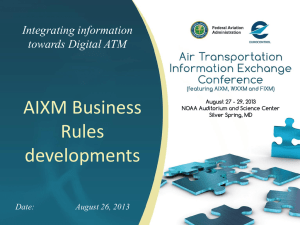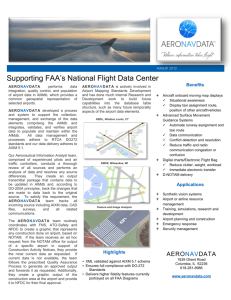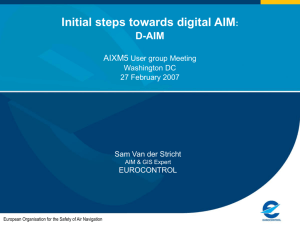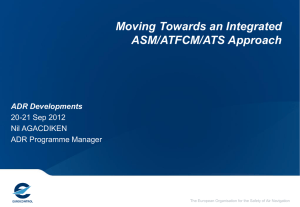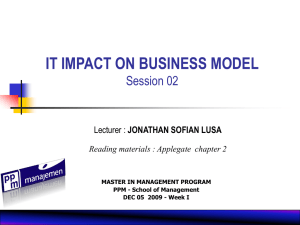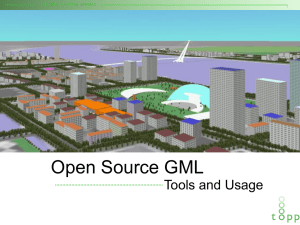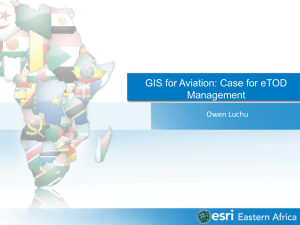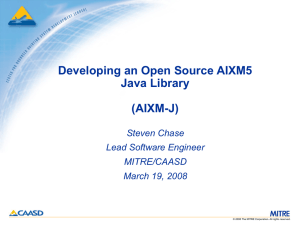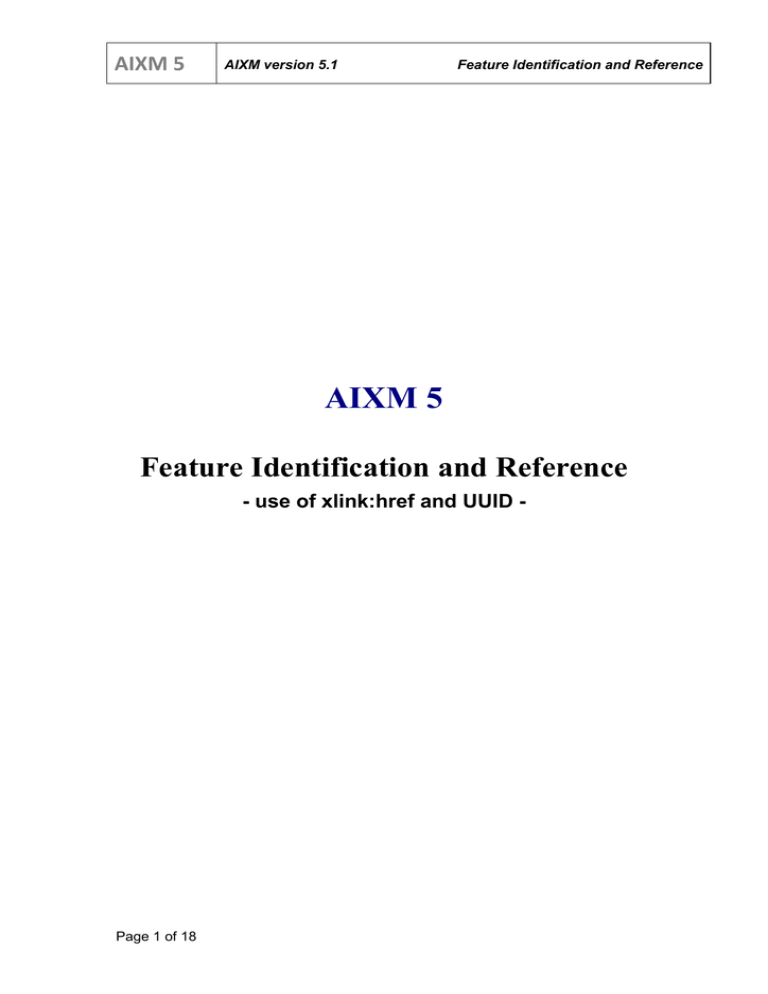
AIXM 5
AIXM version 5.1
Feature Identification and Reference
AIXM 5
Feature Identification and Reference
- use of xlink:href and UUID -
Page 1 of 18
AIXM 5
AIXM version 5.1
Feature Identification and Reference
Aeronautical Information Exchange Model
(AIXM)
Copyright: 2011 - EUROCONTROL and Federal Aviation Administration
All rights reserved.
This document and/or its content can be download, printed and copied in whole or in part, provided
that the above copyright notice and this condition is retained for each such copy.
For all inquiries, please contact:
Deborah COWELL - deborah.cowell@faa.gov
Eduard POROSNICU - eduard.porosnicu@eurocontrol.int
Edition
No.
Edition
Issue Date
Author
Reason
for Change
0.1
First
2009
Design Team
First Edition
0.2
Proposed
2010
Design Team
Update
0.3
Proposed
06 Oct 2010
Design Team
Update Abstract references
0.4
Updated
proposal
22 Nov 2010
0.5
Updated
Proposal
21 Dec 2010
0.6
Updated
21 FEB 2011
1.0
Released
29 APR 2011
Page 2 of 18
Included guidelines for UUID
generation. Updated based on
comments and
recommendations received from
the AIXM Forum members and
during the AIXM-XML Seminars
of 2010.
Eurocontrol-FAA
AIXM Design Team
with the contribution of
AIXM Forum members
Updated following latest
comments on the AIXM Forum.
Use of “uuid” URN. Use of URN
only for abstract references.
Updated following discussions
off-line with the most active (on
this subject) AIXM Forum
members
Final release. Added a sentence
in section 2.2 stressing the
importance for UUID to be
allocated by the real
authoritative source for a
feature’s data.
AIXM 5
AIXM version 5.1
Feature Identification and Reference
Table of Contents
1
2
3
Scope........................................................................................... 4
1.1
Introduction.................................................................................................................... 4
1.2
References...................................................................................................................... 4
1.3
Assumptions and Dependencies..................................................................................... 4
Feature identification (UUID)..................................................... 5
2.1
The gml:identifier property ............................................................................................ 5
2.2
Use of UUID .................................................................................................................. 5
2.3
UUID version and codeSpace ........................................................................................ 6
2.4
The gml:id property ....................................................................................................... 6
Feature Reference (xlink:href) .................................................. 8
3.1
Introduction.................................................................................................................... 8
3.2
Concrete local references within a message................................................................... 8
3.3
Concrete external references .......................................................................................... 9
3.4
Abstract references......................................................................................................... 9
3.5
Use of xlink:title........................................................................................................... 11
A.1. UUID algorithms...................................................................... 13
Page 3 of 18
AIXM 5
AIXM version 5.1
Feature Identification and Reference
1 Scope
1.1
Introduction
The Aeronautical Information Exchange Model (AIXM) is a GML 3.2 application schema
meant to allow for the machine-to-machine exchange of aeronautical information in a
structured format. As services that disseminate information in AIXM 5.1 to consumers are
developed, the ability to manage the linkages between aeronautical features is key. This
encompasses the concepts of feature identification and feature reference.
The AIXM 5.1 schema uses the XLink schema bundled with GML 3.2 for representing a
reference between two features. In concert with the XLink standard, the XPointer standard
may be used to address individual XML elements of messages. This document defines a
number of standard cases for how XLinks should be used within an AIXM 5.1 message and
how those XLinks should be resolved by applications.
The AIXM 5.1 schema also relies on the use of universal unique identifiers (UUID) as
artificial identifiers for AIXM features. In fact, they do not identify the feature itself, but the
data that represents that feature in digital aeronautical information management systems.
This document provides guidance with regard to the algorithms that can be used for the
generation of these UUID values.
1.2
1.3
References
[XLINK]
XLink v1.0 Specification http://www.w3.org/TR/xlink
[XPTR]
XPointer Specification http://www.w3.org/TR/xptr
[XPTH]
XPath Specification http://www.w3.org/TR/xpath
[UUID]
Universally unique identifier (theory)
http://en.wikipedia.org/wiki/Universally_unique_identifier
[UUID-AIXM]
Universally Unique Identifier (UUID) Analysis, by Robert
DeBlanc, MITRE, in support to FAA
[UUID-ISO]
ISO/IEC 9834-8, which is also ITU-T Rec
http://www.itu.int/ITU-T/studygroups/com17/oid.html
x.667
Assumptions and Dependencies
This document assumes that the systems in question are communicating using messages
or data sets that comply with the AIXM 5.0, 5.1 or later schema version.
Page 4 of 18
AIXM 5
AIXM version 5.1
Feature Identification and Reference
2 Feature identification (UUID)
2.1
The gml:identifier property
Each AIXM Feature is identified through the use of the identifier property, which is inherited
from the abstract AIXMFeature. In the AIXM XML Schema, this is mapped to the
gml:identifier property, which all AIXM features inherit from the gml:DynamicFeatureType.
According to the AIXM Temporality Concept, the identifier property is the only time-invariant
property; therefore it is situated outside the TimeSlice complex object, which encapsulates
all the feature properties that can change in time. The gml:identifier property can be
transmitted along with any Feature TimeSlice, allowing to identify the feature to which the
TimeSlice belongs.
There are two essential requirements for the identifier property:
1. to be unique – there should exist a reasonable confidence that an identifier will
never be unintentionally used by anyone for anything else;
2. to be universal – the same identifier should be used in all systems to identify a
given AIXM Feature.
2.2
Use of UUID
The first requirement can be satisfied through the use of Universal Unique Identifiers
(UUID). UUID generation algorithms can guarantee that the risk for the same UUID value to
be generated by another system, for another feature, is extremely low. Information about
such algorithms is provided in Appendix 1 of this document.
Concerning the second requirement, it is important to note that the identifier does not
identify a feature. It identifies the data that someone has about a feature! In order to get
maximum benefit from UUID, they should be generated by the primary originator
(authoritative source) for that feature data.
Ideally, all stakeholders should have the same data about a given feature. However, as
multiple “pseudo-primary” information sources may exist for the same data item or because
the digital data transmission chain may be broken or duplicated, this cannot be guaranteed,
at least on short term. Ensuring that the same gml:identifier is used in all systems for a
given AIXM feature is a requirement for the information management process; therefore, it
needs to be taken care through the process rules. From this point of view, UUIDs can
indicate the continuity and the coherence of the data chain. If two systems use the same
UUID for a feature, this indicates that either:
-
they have the data from the same source (could be one of the two system, or a third
one), or
-
there are processes in place that ensure the consistency of the data between the
two systems.
It is therefore possible that two or more information sets (list of TimeSlices) exists for the
same AIXM feature, in two different systems, with different gml:identifier values. When data
from different sources is merged in a single system, the owner of that system might be
confronted with the need to identify and merge duplicate feature data, based on actual
properties of the feature, not on the gml:identifier.
Overall, the most important advantage of using UUID as gml:identifier in AIXM is for
software development. It is much simpler and less error prone to write code that relies on
Page 5 of 18
AIXM 5
AIXM version 5.1
Feature Identification and Reference
UUID for feature identification and reference, as compared the use any kind of “natural key”
combination.
2.3
UUID version and codeSpace
On the basis of the analysis presented in Appendix 1, the use of version 4 UUID based on
random number generation, is recommended for AIXM. An example of a gml:identifier
using a UUID value is provided below.
<gml:identifier
codeSpace="urn:uuid:">a82b3fc9-4aa4-4e67-8defaaea1ac595j</gml:identifier>
Information about UUID generation capabilities in common software is provided in Appendix
1, section A.1.9.
Note that a Uniform Resource Name (URN) is used as codeSpace for the gml:identifier. The
ISO/IEC 9834-8 or RFC 4122 (http://www.ietf.org/rfc/rfc4122.txt) provide the UUID
codeSpace value “urn:uuid:”.
2.4
The gml:id property
Every GML object is required to have a gml:id value, which is intended as a local unique
identifier, within the XML data set. AIXM features also being GML objects, they must have a
gml:id value as well. In addition, all other GML objects inside the feature (TimeSlice,
gml:TimePeriod, gml:Point, aixm:SurfaceCharacteristics, aixm:AirspaceVolume, etc.) are
also required to have a gml:id values, as shown in the example below:
<aixm:Airspace gml:id="…">
<gml:identifier
codeSpace="urn:uuid:">a82b3fc9-4aa4-4e67-8defaaea1ac595j</gml:identifier>
<aixm:timeSlice>
<aixm:AirspaceTimeSlice gml:id="…">
<gml:validTime>
<gml:TimePeriod gml:id="…">
<gml:beginPosition>2010-06-29T17:31:00</gml:beginPosition>
<gml:endPosition>2010-06-29T19:00:00</gml:endPosition>
</gml:TimePeriod>
</gml:validTime>
<aixm:interpretation>BASELINE</aixm:interpretation>
<aixm:sequenceNumber>1</aixm:sequenceNumber>
<aixm:type>D</aixm:type>
<aixm:geometryComponent>
<aixm:AirspaceGeometryComponent gml:id="…">
<aixm:theAirspaceVolume>
<aixm:AirspaceVolume gml:id="…">
<aixm:upperLimit uom="FT">500</aixm:upperLimit>
<aixm:upperLimitReference>MSL</aixm:upperLimitReference>
<aixm:lowerLimit uom="FT">GND</aixm:lowerLimit>
<aixm:lowerLimitReference>MSL</aixm:lowerLimitReference>
<aixm:horizontalProjection>
<aixm:Surface gml:id="…">
<gml:patches>
<gml:PolygonPatch>
<gml:exterior>
...
Page 6 of 18
AIXM 5
AIXM version 5.1
Feature Identification and Reference
</aixm:Airspace>
The gml:id value has to comply with the same rules as any other XML ID attribute: to be
unique within the XML file, to start with a letter, etc.
It is recommended that the gml:id of the AIXM features (such as aixm:Airspace,
aixm:Runway, etc.) also make use of the UUID value, prefixed with “uuid.”. Since UUID are
globally unique, they are also locally unique and thus perfect candidates for gml:id.
Attention, this recommendation concerns only the AIXM Feature level, not the lower levels,
such as aixm:AirspaceTimeSlice, etc. The use of the feature UUID as gml:id will facilitate
the implementation of concrete xlink:href references using the direct ‘#ID’ syntax, as
explained in 3.1.
Applied to the previous example, these recommendations give the following gml:id values:
<aixm:Airspace gml:id="uuid.a82b3fc9-4aa4-4e67-8def-aaea1ac595j">
<gml:identifier
codeSpace="urn:uuid:">a82b3fc9-4aa4-4e67-8defaaea1ac595j</gml:identifier>
<aixm:timeSlice>
<aixm:AirspaceTimeSlice gml:id="ID00001">
<gml:validTime>
<gml:TimePeriod gml:id="ID00002">
<gml:beginPosition>2010-06-29T17:31:00</gml:beginPosition>
<gml:endPosition>2010-06-29T19:00:00</gml:endPosition>
</gml:TimePeriod>
</gml:validTime>
<aixm:interpretation>BASELINE</aixm:interpretation>
<aixm:sequenceNumber>1</aixm:sequenceNumber>
<aixm:type>D</aixm:type>
<aixm:geometryComponent>
<aixm:AirspaceGeometryComponent gml:id="ID00003">
<aixm:theAirspaceVolume>
<aixm:AirspaceVolume gml:id="ID00004">
<aixm:upperLimit uom="FT">500</aixm:upperLimit>
<aixm:upperLimitReference>MSL</aixm:upperLimitReference>
<aixm:lowerLimit uom="FT">GND</aixm:lowerLimit>
<aixm:lowerLimitReference>MSL</aixm:lowerLimitReference>
<aixm:horizontalProjection>
<aixm:Surface gml:id="ID00005">
<gml:patches>
<gml:PolygonPatch>
<gml:exterior>
...
</aixm:Airspace>
Page 7 of 18
AIXM 5
AIXM version 5.1
Feature Identification and Reference
3 Feature Reference (xlink:href)
3.1
Introduction
Associations between AIXM Features are implemented in the AIXM XML Schema through
the use of XLinks [XLINK].
The general recommendation is to use the gml:identifier (UUID) of the referenced AIXM
Feature. This supports many commercial solutions out-of-the-box, as it relies entirely on the
XLink, XPointer and XPath standards. It is critical that every XLink value points to the
correct feature of interest. For example, that an xlink value identifying an Airspace holds the
identifier of an Airspace feature, not the one of a Runway or another feature, message, etc.
However, this cannot be ensured by the XML Schema and it needs to be dealt with as part
of the data validation rules.
If the UUID is not available, a natural key search can be used. In general, the verbosity of
such a request may increase as finding the key will require querying into a TimeSlice of the
AIXM Feature.
From the point of view of the Xlink target, there exist three cases of interest:
1. Concrete local references within a data set;
2. Concrete external references resolved via web services;
3. Abstract references to be resolved by the consuming application.
These are described in more detail in the following sub-sections.
3.2
Concrete local references within a message
In some cases, services producing AIXM 5.1 data will provide data sets in which all the
referenced features are included. Instead of a reference by gml:identifier, a simpler local
reference to the gml:id attribute could be used in this case. The gml:id is, by definition,
unique within an XML file. Therefore, when used for local references, it is unambiguous.
The gml:id attributes are defined as identifiers in the schema and can be indexed during
parsing.
An example is provided below. Note that the recommendation made in 2.4 is applied here,
which means the gml:id of the Airspace feature is actually based on the UUID value of the
gml:Identifier.
<aixm:Airspace gml:id="uuid.:a82b3fc9-4aa4-4e67-8def-aaea1ac595j">
<gml:identifier
codeSpace="urn:uuid:">a82b3fc9-4aa4-4e67-8defaaea1ac595j</gml:identifier>
...
</aixm:Airspace>
...
<aixm:AirTrafficControlService gml:id="uuid.d4d33081-54ad-4c1a-9519b5b67de561ae">
<aixm:timeSlice>
<aixm:AirTrafficControlServiceTimeSlice
gml:id="AirTrafficControlService01_TS1">
<gml:validTime>
<gml:TimePeriod gml:id="AirTrafficControlService01_TS1_TP1">
<gml:beginPosition>2008-01-01T00:00:00</gml:beginPosition>
<gml:endPosition indeterminatePosition="unknown"/>
Page 8 of 18
AIXM 5
AIXM version 5.1
Feature Identification and Reference
</gml:TimePeriod>
</gml:validTime>
<aixm:interpretation>BASELINE</aixm:interpretation>
<aixm:type>ACS</aixm:type>
<aixm:clientAirspace xlink:href="#uuid.a82b3fc9-4aa4-4e67-8defaaea1ac595j"/>
</aixm:AirTrafficControlServiceTimeSlice>
</aixm:timeSlice>
</aixm:AirTrafficControlService>
3.3
Concrete external references
When information about features is exposed via web services, a method by which XLinks
can be resolved is via a Universal Resource Locator (URL).
In this case, the expectation is that the consumer of the message can follow the URL
provided in the XLink directly and the hashtag will identify the feature within the resultant
resource to which this reference resolves. If the recommendation made in 2.4 was applied
and the target feature has a UUID based gml:id, then the concrete reference may be
encoded using simply the ‘#ID’ reference syntax, as in the example below:
<aixm:clientAirspace
xlink:href="http://aim.faa.gov/services/AirspaceService#uuid.a82b3fc94aa4-4e67-8def-aaea1ac595j"/>
A more general, but also much more complex solution is to use xpointer. Again, the
combination of the URL and the XPointer should result in the tag which resolves to the
feature which is referenced.
<aixm:clientAirspace
xlink:href="http://aim.faa.gov/services/AirspaceService?get=a82b3fc9-4aa44e67-8defaaea1ac595j#xmlns(ns1=http://www.opengis.net/gml/3.2)xmlns(ns2=http://www.
aixm.aero/schema/5.1)xpointer(//ns2:Airspace[ns1:identifier=’a82b3fc94aa4-4e67-8def-aaea1ac595j’])"/>
Note that the above URL is independent of implementation. It may identify a (Web Feature
Server) WFS server, but it could also be an implementation of a simple web service which
returns a particular set of features based on the user’s query. As long as the resolution of
the URL produces an XML document which contains the AIXM Feature, the above is a valid
reference.
The approach for the first two cases (concrete local or external references) is based purely
on the XLink and XPointer standard: there is no application-specific logic required to resolve
the reference. However, implementers should take care to take advantage of caching
strategies to avoid continually resolving features for which they already have definitions.
3.4
Abstract references
Xlink assumes a “resource centered approach”, in which the XML document or fragment is
a resource which can be referenced from anywhere. It assumes that the resource is
available on the web in a single, definitive copy. In the aeronautical information domain, the
feature is an entity which can be globally referenced but there are many representations of
that feature in circulation. Many of those representations are in AIXM messages; others are
in databases or applications. This is why the use of concrete references is rare and the use
of abstract references needs to be considered as well.
Abstract references fit very well to the GML paradigm since they provide a reference to the
abstract idea of the feature, rather than one of its representations. Resolving the abstract
Page 9 of 18
AIXM 5
AIXM version 5.1
Feature Identification and Reference
reference to a physical one is the problem of the application and it can deal with issues of
multiple copies in all the messages, databases etc. that it knows about.
Leaving the resolution with the application also allows the application to adapt to its context.
For example, if the application is off-line it could choose to use a locally cached copy of the
feature. An on-line application could go to the definitive web-service for the feature.
In those cases, the xlink:href should use a universal resource name (URN) rather than a
URL; note that URNs, unlike URLs, cannot be directly used to find a resource. In the case
where a URN is presented to the consumer, it is the responsibility of the consuming
application to resolve the reference.
Nothing in the use of a URN implies the availability of the referenced feature or its location;
it may be that the feature is defined locally within the message, accessible remotely by a
web service, or directly through a database access.
In general, the following three steps will be followed:
1. The recipient of the data will use the identifier of the referenced feature to search its
local database.
2. If no such feature exists in its local data set, the incoming data set would be
searched for the referenced feature.
3. If the above does not find the feature, the system would search known data sources
to resolve the reference.
This type of reference is limiting in its openness, as it requires application logic to be
resolved. As such, its use is expected to be reduced over time, as the aeronautical
information domain moves towards Web service solutions. By using the concrete standards
mentioned above, any standards-complete system can resolve AIXM references without
additional application logic.
3.4.1
Using UUID
It is recommended that the URN is based on the UUID of the referenced feature, as in the
following example
<aixm:clientAirspace xlink:href="urn:uuid:a82b3fc9-4aa4-4e67-8defaaea1ac595j"/>
In this case, the application will consume the URN-based locater and internally discover the
definition of the referenced airspace through data registries, manual coding, or other
methods specific to the systems involved. The beginning of the URN should match the
codeSpace used for gml:identifier.
3.4.2
Using natural keys
When the UUIDs are not available, an AIXM specific URN composed with natural keys
could be used, as in the example below:
<aixm:clientAirspace xlink:href="urn:aixm:Airspace(gml:timePosition=201004-07T09:00;aixm:type=D;aixm:designator=EBD25A)"/>
Apart from being much more complex than those based on UUID, the disadvantage of the
URN based on natural keys is that they requires specific code for decoding and identifying
the target feature. Therefore, URN with natural keys should be used only during transition
periods and on a limited scale. For example, it might be a solution to use natural key based
URN between systems that store the data in legacy formats and which do not have the
possibility to work with UUID values..
Page 10 of 18
AIXM 5
AIXM version 5.1
Feature Identification and Reference
The following rule shall be applied in the composition of the “aixm” URN:
urn:aixm:Feature(timePosition=time_value;property_name=property_value;…)
where:
Feature is the name of an AIXM Feature as defined in the AIXM XML
Schema; for example: AirportHeliport, Airspace, Runway, etc.
time_value is a UTC date and time value in the format yyyy-mm-ddThh:mm
and it indicates the moment in time at which the BASELINE TimeSlice of the
AIXM Feature referred had the property_value(s) that appear in the URN
composition;
property_name is the name of property of an AIXM Feature that composes
a natural key for that feature; the property name shall be spelled according to
the AIXM XML Schema, exactly as it appears as child element of the AIXM
Feature TimeSlice.
It is assumed that all natural key properties are either direct child elements of
the Feature TimeSlice or that they exist only once in the XML tree (such as
the gml:pos of a Navaid).
property_value is the value of the of the property identified by
property_name as defined in the BASELINE TimeSlice of that feature that is
valid at the date and time specific by the time_value;
In some situations, this includes properties that do not directly have a value,
but have an xlink:href attribute that points to another Feature. In this case,
the URN of the referenced feature shall be used as property_value. A typical
example is the Runway feature, for which the natural key includes the
AirportHeliport where it is located. The URN will look like in the example
below:
urn:aixm:Runway(gml:timePosition=2010-1220T16:32;aixm:designator=02%2F20;aixm:associatedAirportHelipor
t=urn:aixm:AirportHeliport(gml:timePosition=
2010-1220T16:32;aixm:designator=EBBR))
Note that the value of an AIXM feature natural key property could contain
characters that are not allowed in the composition of the URN, as explained
in the URN Syntax (RFC 2141) and have to be replaced with their hex code,
prefixed by the character “%”. This is the case for the “/” character, which is
typically used in runway designators. Therefore, in the example above, the
runway designator “02/20” was encoded as “02%2F20”, where “%2F” is the
hex representation of “/”.
In order to be valid URN in terms of the RFC 2141 (URN Syntax), the “aixm” URN would
have to be registered with the Internet Assigned Numbers Authority. Until then, it shall be
considered as a non-standard (experimental) URN.
3.5
Use of xlink:title
The value of the attribute xlink:title on a xlink is a human-readable description of the
referenced value. In this case, it would be a human-friendly description of the referenced
aeronautical feature.
Page 11 of 18
AIXM 5
AIXM version 5.1
Feature Identification and Reference
It is suggested that the xlink:title be used, especially in cases in which the referenced
feature is defined remotely. The title should be a human-friendly name of the feature which
can be used internally by applications for display purposes. It is discouraged to use the
xlink:title for automatic feature identification.
<aixm:clientAirspace xlink:href="urn:uuid:a82b3fc9-4aa4-4e67-8defaaea1ac595j" xlink:title=”Gabbs North MOA”/>
Page 12 of 18
AIXM 5
AIXM version 5.1
Feature Identification and Reference
Appendix 1
A.1. UUID algorithms
A.1.1 Introduction
This Appendix examines the four main versions of the UUID; how they are generated, their
efficiency and their computational overhead. On the basis of this comparison it is found that
the version 4 UUIDI, based on random number generation, is the most efficient. The
tendency in the industry is to move toward the use of version 4, with the notable exception
of Oracle that remains on version 1. A survey of the UUID/Globally Unique Identifier (GUID)
versions supported by the main software products and libraries is summarized in Figure 7.
A.1.2 Definition and Uniqueness
A UUID is a 128-bit number that is encoded either with a random number, the output of a
cryptographic hash function or a combination of a random number and the time of
generation. UUIDs are conventionally written or displayed in their ‘canonical’ form, which is
a sequence of 32 hexadecimal digits grouped into a sequence of 8, 4, 4, 4 and 12 digits; an
example is given below.
550e8400-e29b-41d4-a716-446655440000
The left-most digit of this string represents the most significant four bits of the UUID.
The purpose of the UUID is best described by Wikipedia http://en.wikipedia.org/wiki/UUID
as: “The intent of UUIDs is to enable distributed systems to uniquely identify information
without significant central coordination. ..... …..Anyone can create a UUID and use it to
identify something with reasonable confidence that the identifier will never be unintentionally
used by anyone for anything else.” The UUID is defined in three compatible standards:
ISO/IEC 11578:1996, ITU-T Rec. X.667 | ISO/IEC 9834-8:2005 and IETF RFC 4122.
The reason for the use of a number field as large as [1-2122] is that the UUID is universal,
i.e. the probability of a duplicate UUID being encountered within the IT universe for the
foreseeable future must be a very low.
A.1.3 Format and Versions
The UUID format is depicted in Figure 1. Six of the 128 bits are used to specify the type of
UUID leaving 122 to carry a random number, the output of a cryptographic hash function or
a combination of a Network Interface Card (NIC) MAC address and the time of generation,
depending on the Version of the UUID. The six control bits are very awkwardly placed, and
are not even contiguous, making the generation and interpretation of UUIDs more
complicated than it need have been. The digits are numbered from the left-most digit of the
canonical (string) form. The type of UUID is defined first by the value of the Variant field
(YY) which occupies the most significant two bits of the 17th hex digit.
Note: RFC 4122, paragraph 4.1.1 shows the variant field as having three bits. For all
standard UUIDs the least significant bit of these three is irrelevant; it is used as the top bit of
the clock sequence in version 1 UUIDs, or is part of the random or hash fields in version 3,4
or 5 UUIDs.
A value of 2 in the variant field indicates that the UUID is one of the standard versions. A
zero value of the most significant bit of the variant field indicates that the UUID was
generated by a workstation in the Apollo Network Computing System. A value 3 of the
Page 13 of 18
AIXM 5
AIXM version 5.1
Feature Identification and Reference
variant field indicates a UUID that was used by .COM in versions of Microsoft Windows
before Windows 2000. The Version field (VVVV) is coded into the 13th digit allowing up to
15 UUID versions. Five versions, numbered 1 – 5 currently exist.
Hex
Digits
1
2
3
4
5
6
7
8
1 to 8
XXXX
XXXX
XXXX
XXXX
XXXX
XXXX
XXXX
XXXX
9 to 16
XXXX
XXXX
XXXX
XXXX
VVVV
XXXX
XXXX
XXXX
17 to 24
YYXX
XXXX
XXXX
XXXX
XXXX
XXXX
XXXX
XXXX
25 to 31
XXXX
XXXX
XXXX
XXXX
XXXX
XXXX
XXXX
XXXX
Figure 1 - General Format of UUID
The UUID standards do not require that the UUIDs generated by a given system must all be
of the same version. A closed (i.e. not universal) distributed system, could exploit this by
allowing any of the four main versions to be generated. The degree of uniqueness of the
UUIDs would then be quadrupled, from a field of [1-2122] an effective field of [1-2124].
A.1.4 Version 1 UUID
The version 1 format is the oldest and most complicated, but is still widely used; the
encoding in shown in Figure 2. The 60 bits labeled ‘t’ are the time at which the UUID was
created, in increments of 100 nano-seconds (1x10-7 ) seconds. The 48 bits labeled ‘m’ are
the (universally unique) MAC address of one of the Network Interface Cards (NIC) on the
system; when this is not available a 48-bit random or pseudo-random number is generated.
The 14 clock-sequence bits labeled ‘c’ are used to reduce the possibility of a duplicate UUID
value being generated following the clock being set backwards (after a power outage) or the
NIC card being changed. The field allows for 214 or >16,000 resets in the lifetime of the
system. In the unlikely event that the clock sequence just before the event is known, it can
be used on recovery and just incremented; otherwise the clock sequence is re-initialized
with a random number.
Hex
Digits
1
2
3
4
5
6
7
8
1 to 8
tttt
tttt
tttt
tttt
tttt
tttt
tttt
tttt
9 to tttt
16
tttt
tttt
tttt
0001
tttt
tttt
tttt
17 to 10cc
24
cccc
cccc
cccc
mmmm
mmmm
mmmm
mmmm
25 to mmmm
31
mmmm
mmmm
mmmm
mmmm
mmmm
mmmm
mmmm
Figure 2 - Format of Version 1 UUID – Time and Address
The time field in a version 1 UUID provides the elapsed time, in 100 nanosecond
increments, since the start of the Gregorian calendar in October 1582. The maximum
Page 14 of 18
AIXM 5
AIXM version 5.1
Feature Identification and Reference
(unsigned) value of 260 nanoseconds is equal to about 3663 years. Currently the highest
order bit set in a version 1 UUID time field is the 57th bit. The 58th and higher bits will not be
used until after 2444.
A.1.5 Version 2 UUID
Version 2 UUID is used in the IEEE Portable Operating System Interface POSIX Distributed
Computing Environment. The format is very similar to version 1.
A.1.6 Version 4 UUID
The encoding of a version 4 UUID is shown in Figure 3. The 122 bits labeled ‘r’ comprise a
pseudo-random number, or preferably a cryptographic quality random number.
Hex
Digits
1
2
3
4
5
6
7
8
1 to 8
rrrr
rrrr
rrrr
rrrr
rrrr
rrrr
rrrr
rrrr
9 to 16
rrrr
rrrr
rrrr
rrrr
0100
rrrr
rrrr
rrrr
17 to 24
10rr
rrrr
rrrr
rrrr
rrrr
rrrr
rrrr
rrrr
25 to 31
rrrr
rrrr
rrrr
rrrr
rrrr
rrrr
rrrr
rrrr
Figure 3 - Format of Version 4 UUID – Random Number
After a distributed system starts generating version 4 UUIDs, if a source of cryptographic
quality random numbers is used, the probability that it will generate a duplicate UUID of one
already generated p(n;d) is given by the expression 1 – e-nxn/2d where the number already
generated is 2n and d is the number of bits occupied by the random number. The probability
of a collision will be higher if pseudo-random numbers generated by the system are used.
As an example, after 243 (≈8.8 trillion) UUIDs have been generated, the probability of the
next UUID being a duplicate of one already generated is ≈ 7.276x10-12. Figure 4 gives p(n;d)
for values of n: 36, 41, 43 and 46 and values of d: 90, 106 and 122. {calculated with R
Statistical Language}. The fourth column of the table shows that taking 4 octets of the
random number field for another use would introduce a significant probability of collisions
occurring.
d = 122
d = 106
d = 90
n = 36
4.44x10-16
2.91x10-11
1.19x10-6
n = 41
4.55x10-13
2.98x10-8
1.95x10-3
n = 43
7.28x10-12
4.77x10-7
3.08x10-2
n = 46
4.66x10-10
3.05x10-5
8.65x10-1
Figure 4 - Probability of Collision for Version 4 (Random Number) UUIDs
Page 15 of 18
AIXM 5
AIXM version 5.1
Feature Identification and Reference
A.1.7 Versions 3 and 5 UUID
The encoding of a version 3 or version 5 UUID is shown in Figure 5. The bits labeled ‘h’ are
the output of an MD5 cryptographic hash function in version 3 UUIDs and are the output of
a SHA-1 cryptographic hash function in version 5 UUIDs. The hash function values of 128
bits (MD5) and 160 bits (SHA-1) are truncated to the 122 bits available in the UUID.
Hex
Digits
1
2
3
4
5
6
7
8
1 to 8
hhhh
hhhh
hhhh
hhhh
hhhh
hhhh
hhhh
hhhh
9 to 16
hhhh
hhhh
hhhh
hhhh
0011/0101
hhhh
hhhh
hhhh
17 to
24
10rr
hhhh
hhhh
hhhh
hhhh
hhhh
hhhh
hhhh
25 to
31
hhhh
hhhh
hhhh
hhhh
hhhh
hhhh
hhhh
hhhh
Figure 5 - Format of Version 3 or Version 5 UUID
Information about the MD5 algorithm can be found at http://www.w3.org/TR/1998/REC-DSiglabel/MD5-1_0, and about the SHA-1 algorithm at http://www.itl.nist.gov/fipspubs/fip180-1.htm.
Both of these algorithms have been ‘broken’ by systematic attacks; in the case of MD5
within 243 hash operations and in the case of SHA-1 within 263 hash operations. These are
well below the number of operation that can be guaranteed to produce a collision, 264 and
280 respectively. However this has no implications for the use of hash numbers in UUIDs,
where they are used more for convenience than for security, other than to suggest that the
uniqueness of a UUID formed with either of these algorithms will be less than that of a
version 4 UUID formed with a random number of cryptographic quality.
A.1.8 Comparisons of UUID Versions
Efficiency of bit usage
The time algorithm used in version 1 UUIDs is inefficient in its granularity of 100
nanoseconds. The 56th bit of the 60-bit time field was not used until some time in 1986, and
the 57th bit will not be used until 2444. This means that the top 4 bits are effectively not
being used. Also, the 14 bit clock sequence field in version 1 UUIDs is only used each time
the system is powered up, allowing for 214 or >16,000 resets in the lifetime of the system. A
lower number of bits would provide for a sufficient number of resets, given that a recycling
of this field would not produce UUIDs with an ambiguous time of generation.
In contrast to version 1 UUIDs, in versions 3, 4 and 5 UUIDs all 122 available bits are used
to hold either a random number or the output of a hash function.
Computational overhead
An April 2007 test to compare the times taken to generate version 1, version 3 and version
4 UUIDs { http://johannburkard.de/blog/programming/java/Java-UUID-generators-compared.html }
showed the following average times to generate 1 million UUIDs with standard Java
software:
Page 16 of 18
AIXM 5
AIXM version 5.1
Feature Identification and Reference
Version 1 Time based
5,432
milliseconds
Version 3 MD5 based
40, 788 milliseconds
Version 4 Random number based
48, 900 milliseconds
Figure 6 - Average times for UUID generation
These results show that versions 3 and 4 UUIDs incur substantially higher processing
overhead than version 1 UUIDs: by a factor of about 7.5 for version 4 and a factor of about
9 for version 3.
The SHA-1 algorithm generates a 160 bit hash compared to the 128 bits generated by the
MD5 algorithm. When used in a UUID, both hashes are truncated to 122 bits, so any
advantage in security or randomness that the SHA-1 might have over MD5 is obviated when
it is used in a UUID.
Uniqueness
The timestamp field in the version 1 UUID is not a random number. Each bit changes with
half the frequency of the preceding, less significant bit; the 48th and higher bits change less
than once a year. More significant is the devotion of 14 bits to the clock sequence field,
which is only incremented each time a system is switched back on. The Version 1 UUIDs
are therefore substantially less unique than either Version 3 or Version 4 UUIDs.
The uniqueness of version 3 or 5 UUIDs can not be greater than the uniqueness of version
4 UUIDs and may be less, given the fact that they can both be compromised after a number
of uses that is well below the number at which duplication could be expected (“brute force
attack”): 243 instead of 264 in the case of MD5 and 263 instead of 280 in the case of SHA-1.
A.1.9 Support by Common Software
It is sometimes difficult to establish what versions of UUID are supported by a particular
software application, as many users and even product announcements do not seem to be
aware that five distinct versions exist. Typically the output of a UUID generator is only
described as several groups of hexadecimal digits. Oracle is notable in this respect, simply
defining its UUID as a 16 byte raw value. In the case of Microsoft, it was difficult to untangle
because UUIDs are used extensively within Microsoft packages; only one of many
interfaces in the Microsoft Component Object Model (COM), and now in the .NET
framework, use the type of UUIDs included in this study. Microsoft switched from using
version 1 to version 4 with the introduction of .NET and Windows 2000.
Although a particular application package may not support a given version of a UUID, in
many cases an extension to support that version can be added from libraries such as the
UNIX-based Open Source Software Project (OSSP).
Version 1
Version 3
Version 4
Version 5
Microsoft
.COM
Microsoft
Windows
2000
Oracle
Java (JUG)
Java J2SE5
Page 17 of 18
X
X
X
X
X
X
X
X
Variant
3
AIXM 5
JavaScript
AIXM version 5.1
Feature Identification and Reference
X
uuid.js
Linux (ossp)
MySQL
X
X
X
X
X
Version 1
MySQL
current
PostgreSQL
Apache
X
X
X
X
X
X
X
X
X
X
X
X
X
X
X
X
X
X
X
X
X
(Jakarta project)
OpenPKG
Python
Ruby
C++ (ossp)
Figure 7 - UUID Versions Supported by Common Software
Page 18 of 18

